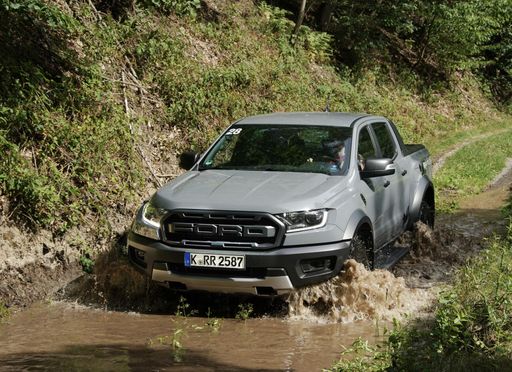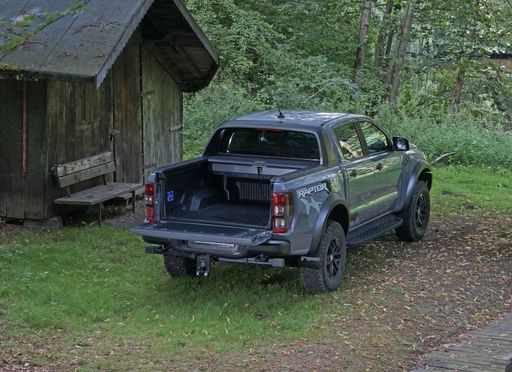Ford Ranger vs Porsche Cayman – Differences & prices compared
Compare performance, boot space, consumption and price in one view.
Find out now: which car is the better choice for you – Ford Ranger or Porsche Cayman?
The Ford Ranger (Pickup) comes with a Diesel, Petrol or Plugin Hybrid engine and Manuel or Automatic transmission. In comparison, the Porsche Cayman (Coupe) features a Petrol engine with Automatic transmission.
When it comes to boot capacity, the Ford Ranger offers , while the Porsche Cayman provides 184 L – depending on how much space you need. If you’re looking for more power, decide whether the 292 HP of the Ford Ranger or the 500 HP of the Porsche Cayman suits your needs better.
In terms of consumption, the values are 3.10 L per 100 km for the Ford Ranger, and 13 L for the Porsche Cayman.
Price-wise, the Ford Ranger starts at 34500 £, while the Porsche Cayman is available from 136000 £. Compare all the details and find out which model fits your lifestyle best!
Ford Ranger
The Ford Ranger stands out in the pickup market with its robust build and versatile capabilities, making it a popular choice for both work and leisure. Its modern design is complemented by a well-equipped interior, providing comfort and advanced technology. Whether tackling challenging terrains or cruising through the city, the Ranger delivers a reliable and dynamic driving experience.
details @ media.ford.com
@ media.ford.com
 @ media.ford.com
@ media.ford.com
Porsche Cayman
The Porsche Cayman stands out as a quintessential sports car, blending sleek design with dynamic handling. Its mid-engine layout provides an excellent balance and sharp agility that driving enthusiasts crave. Inside, the Cayman offers a refined and driver-focused interior, ensuring that every journey is an exhilarating experience.
details

|
|
|
|
|
Costs and Consumption |
|
|---|---|
|
Price
34500 - 68800 £
|
Price
136000 £
|
|
Consumption L/100km
3.1 - 13.8 L
|
Consumption L/100km
13 L
|
|
Consumption kWh/100km
-
|
Consumption kWh/100km
-
|
|
Electric Range
50 km
|
Electric Range
-
|
|
Battery Capacity
11.80 kWh
|
Battery Capacity
-
|
|
co2
70 - 315 g/km
|
co2
295 g/km
|
|
Fuel tank capacity
80 L
|
Fuel tank capacity
54 L
|
Dimensions and Body |
|
|---|---|
|
Body Type
Pickup
|
Body Type
Coupe
|
|
Seats
2 - 5
|
Seats
2
|
|
Doors
2 - 4
|
Doors
2
|
|
Curb weight
2082 - 2486 kg
|
Curb weight
1490 kg
|
|
Trunk capacity
-
|
Trunk capacity
184 L
|
|
Length
5370 - 5420 mm
|
Length
4456 mm
|
|
Width
1918 - 1968 mm
|
Width
1822 mm
|
|
Height
1868 - 1922 mm
|
Height
1267 mm
|
|
Payload
676 - 1108 kg
|
Payload
281 kg
|
Engine and Performance |
|
|---|---|
|
Engine Type
Diesel, Petrol, Plugin Hybrid
|
Engine Type
Petrol
|
|
Transmission
Manuel, Automatic
|
Transmission
Automatic
|
|
Transmission Detail
Manual Gearbox, Automatic Gearbox
|
Transmission Detail
Dual-Clutch Automatic
|
|
Drive Type
All-Wheel Drive
|
Drive Type
Rear-Wheel Drive
|
|
Power HP
170 - 292 HP
|
Power HP
500 HP
|
|
Acceleration 0-100km/h
7.9 - 12.1 s
|
Acceleration 0-100km/h
3.40 s
|
|
Max Speed
180 - 190 km/h
|
Max Speed
315 km/h
|
|
Torque
405 - 697 Nm
|
Torque
450 Nm
|
|
Number of Cylinders
4 - 6
|
Number of Cylinders
6
|
|
Power kW
125 - 215 kW
|
Power kW
368 kW
|
|
Engine capacity
1996 - 2993 cm3
|
Engine capacity
3996 cm3
|
General |
|
|---|---|
|
Model Year
2022 - 2025
|
Model Year
2021
|
|
CO2 Efficiency Class
G, B
|
CO2 Efficiency Class
G
|
|
Brand
Ford
|
Brand
Porsche
|
Ford Ranger
A Comprehensive Look at the Ford Ranger: Versatility Meets Innovation
The Ford Ranger has long been a staple in the world of pick-up trucks, renowned for its robust design and versatility. Whether for rugged off-road adventures or everyday utility tasks, the Ford Ranger continues to be a frontrunner in the pick-up segment. In this article, we explore the technical details and innovative features that set the latest versions of the Ford Ranger apart from its competitors.
Powertrain Performance: A Range of Choices
The Ford Ranger offers a selection of powerful engines, catering to a diverse set of user requirements. Engine options range from the fuel-efficient 2.0-litre EcoBlue diesel engine to the robust 3.0-litre EcoBoost petrol engine, offering impressive outputs from 170 to 292 PS. These engines are paired with either a manual or an advanced automatic transmission, both providing smooth shifting and optimised performance across various driving conditions.
The Ranger’s all-wheel-drive system ensures a robust off-road capability while maintaining a composed ride on urban roads. With torque figures ranging between 405 Nm and 600 Nm, the Ranger guarantees ample pulling power whether you're on or off the beaten track.
Fuel Efficiency and Environmental Considerations
Recognising the importance of balancing performance with efficiency, the Ford Ranger delivers competitive fuel consumption figures ranging from 8.4 to 13.8 litres per 100 km. Despite its robust performance capabilities, the Ranger remains mindful of its environmental footprint, maintaining a functional balance between power and efficiency with a CO2 efficiency class of G.
Advanced Safety and Technology Features
Incorporating cutting-edge technology, the Ford Ranger is equipped with a suite of safety features designed to protect both passengers and payload. Among these are adaptive cruise control, lane-keeping assistance, and a pre-collision assist system, enhancing the driver's ability to navigate both rural roads and busy motorways safely and efficiently.
Moreover, the interior tech suite includes an intuitive infotainment system, complete with connectivity options for seamless integration of smartphones and smart devices. This ensures drivers and passengers can stay connected and entertained on all journeys.
Customisation and Comfort
The Ford Ranger offers a variety of trim levels, allowing customers to tailor the vehicle to their specific needs. From the rugged XL 4x4 to the luxurious Platinum e-4WD Automatik, there is a model to suit every preference and requirement. Equipment lines such as Wildtrak and MS-RT add enhanced styling and additional features for those seeking a more distinctive and upscale appearance.
Inside, the Ranger provides comfortable seating configurations for up to five passengers, with premium materials and ample storage space to ensure every journey is a pleasant experience. Users can also benefit from a range of comfort features, including climate control, premium audio systems, and adjustable seating.
Practicality Meets Payload
The Ford Ranger excels in practicality with its impressive payload capacity and spacious cargo bed, suitable for carrying everything from work equipment to recreational gear. With a maximum payload of up to 1,108 kg, the Ranger is more than capable of handling heavy loads, making it an ideal choice for both professional and personal use.
Additionally, the robust chassis and durable build quality provide long-lasting performance even under the most demanding conditions, ensuring reliability and endurance in the long term.
Conclusion: A Resilient Companion for All Terrains
With its capable engine choices, outstanding off-road capabilities, and a host of advanced features, the Ford Ranger continues to lead the way in the pick-up truck category. Whether for practical utility, adventurous pursuits, or simply as a reliable daily vehicle, the Ranger delivers on all fronts – a true testament to Ford’s commitment to innovation and quality in the automotive industry.
Porsche Cayman
The Porsche Cayman: A Masterclass in Precision Engineering
For decades, Porsche has been synonymous with precision, power, and unparalleled driving experience. The Porsche Cayman, particularly the newest iteration like the 718 Cayman GT4 RS, continues this legacy with a suite of cutting-edge technical features and exhilarating performance capabilities. Nestled in the sports car segment, this coupe has been engineered to provide an almost symbiotic relationship between car and driver.
Performance that Blazes a New Trail
The heart of the Cayman GT4 RS is a robust 4.0-liter naturally aspirated flat-six engine, pushing out an astounding 500 horsepower. This engine provides a visceral connection to the road, combined with a curiously addictive exhaust note that Porsche enthusiasts have come to love. With 450 Nm of torque, the acceleration feels unyielding, propelling the car from 0 to 100 km/h in a mere 3.4 seconds. Coupled with a PDK dual-clutch automatic transmission, each gear change feels precise and instantaneous, making it an exhilarating drive on both road and track.
Innovative Design Meets Functionality
The Porsche Cayman has always showcased a balance of aesthetic elegance and aerodynamic functionality. With a length of 4456 mm, width of 1822 mm, and a height of 1267 mm, the dimensions are tightly packed for optimal stability and agility. The coupe's 1490 kg curb weight contributes to its nimbleness, while the rear-wheel-drive configuration ensures a pure sports-car feel.
Efficiency Coupled with Performance
While performance is at the core of the Porsche ethos, efficiency hasn't been compromised. The Cayman GT4 RS has a fuel consumption rate of 13 L/100 km, striking an impressive balance between power and sustainability, although it maintains a CO2 efficiency class of G, indicative of its performance-oriented design.
Details that Make a Difference
Inside the cabin, the Cayman is fitted to perfection with a focus on the driver-centric experience. Despite its sporty DNA, it doesn't skimp on comfort—there's ample seating for two alongside a sizable trunk capacity of 184 liters, enhancing its practicality for weekend getaways.
Additionally, the car boasts a CO2 emission of 295 g/km and supports a payload of 281 kg, underscoring its utility without detracting from its core focus on high performance.
The Ultimate Driving Machine?
With a top speed of 315 km/h, the Cayman GT4 RS lives up to its billing as a track-bred sports car. The precision engineering, combined with innovative technological integrations, sets it apart from contemporaries in its class. While the sleek exterior exudes luxury, it's the engineering beneath that makes the Cayman an acme of what a modern sports coupe can achieve.
In the Porsche Cayman, enthusiasts meet a machine so finely tuned and so divinely balanced that it stands as a testament to the relentless pursuit of perfection—a masterpiece of modern automotive engineering.
Which drive types are available for the Ford Ranger?
Available as .
The prices and data displayed are estimates based on German list prices and may vary by country. This information is not legally binding.
